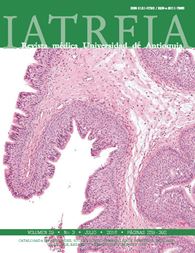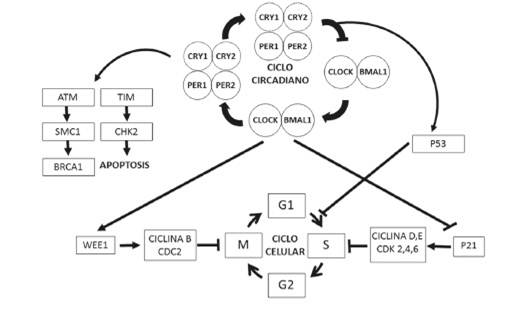The circadian rhythms in cancer and chronotherapy
DOI:
https://doi.org/10.17533/udea.iatreia.v29n3a05Keywords:
acute lymphocytic leukemia, cancer, chronotherapy, circadian rhythms, colonic neoplasms, endometrial neoplasmsAbstract
Circadian rhythms, physiological periods of about 24 hours, coordinate the temporal processes of most, or maybe all, living beings on the planet. Cell proliferation, one of the most important events in the body, is also regulated by the biological clock, whose alteration may have a direct impact on cancer development. The concept of chronotherapy comes from evidence showing that both cell proliferation and the mechanisms responsible for pharmacokinetics and pharmacodynamics of antineoplastic drugs occur at specific times of the day. This review presents an overview of the circadian cycle and its relation to cell cycle and cancer. Also, it presents evidence for the use of chronotherapy in patients with acute lymphocytic leukemia and in randomized clinical trials for colon, endometrial and ovarian cancer. As a conclusion, the time of chemotherapy administration should take into account the circadian rhythms of patients. We emphasize on the need to conduct clinical trials focused on chronomodulated chemotherapy, in order to increase the tolerance and effectiveness of drugs under the existing protocols.
Downloads
References
(1.) Roenneberg T, Kuehnle T, Juda M, Kantermann T, Allebrandt K, Gordijn M, et al. Epidemiology of the human circadian clock. Sleep Med Rev. 2007 Dec;11(6):429-38.
(2.) Arellanes-Licea E, Caldelas I, De Ita-Pérez D, Díaz-Muñoz M. The circadian timing system: a recent addition in the physiological mechanisms underlying pathological and aging processes. Aging Dis [Internet]. 2014 Dec [cited 2015 Jan 8];5(6):[406-18]. Available from: http://www.pubmedcentral.nih.gov/articlerender.fcgi?artid=4249810&tool=pmcentrez&rendertype=abstract
(3.) Golombek DA, Casiraghi LP, Agostino P V, Paladino N, Duhart JM, Plano SA, et al. The times they’re achanging: effects of circadian desynchronization on physiology and disease. J Physiol Paris [Internet]. 2013 Sep [cited 2015 Aug 6];107(4):[310-22]. Available from: http://www.sciencedirect.com/science/article/pii/S0928425713000090
(4.) Megdal SP, Kroenke CH, Laden F, Pukkala E, Schernhammer ES. Night work and breast cancer risk: a systematic review and meta-analysis. Eur J Cancer [Internet]. 2005 Sep [cited 2015 Jan 6];41(13):[2023-32]. Available from: http://www.sciencedirect.com/science/article/pii/S0959804905004910
(5.) Costa G, Haus E, Stevens R. Shift work and cancer - considerations on rationale, mechanisms, and epidemiology. Scand J Work Environ Health. 2010 Mar;36(2):163-79. DOI 10.5271/sjweh.2899
(6.) Straif K, Baan R, Grosse Y, Secretan B, El Ghissassi F, Bouvard V, et al. Carcinogenicity of shift-work, painting, and fire-fighting. Lancet Oncol. 2007 Dec;8(12):1065-6.
(7.) Gillette MU. SCN electrophysiology in vitro: Rhythmic activity and endogenous clock properties. In: Klein DC, Moore RY, Reppert SM. Suprachiasmatic Nucleus: The Mind’s Clock. Oxford: Oxford University Press; 1991. p. 125-43.
(8.) Reppert SM, Weaver DR. Coordination of circadian timing in mammals. Nature. 2002 Aug;418(6901):935-41. DOI 10.1038/nature00965.
(9.) Hastings MH, Herzog ED. Clock genes, oscillators, and cellular networks in the suprachiasmatic nuclei. J Biol Rhythms [Internet]. 2004 Oct [cited 2011 Jul 29];19(5):[400-13]. Available from: http://jbr.sagepub.com/content/19/5/400.long
(10.) Rusak B, Zucker I. Neural regulation of circadian rhythms. Physiol Rev. 1979 Jul;59(3):449-526.
(11.) Hofman MA, Swaab DF. The human hypothalamus: comparative morphometry and photoperiodic influences. Prog Brain Res. 1992;93:133-47.
(12.) Ko CH, Takahashi JS. Molecular components of the mammalian circadian clock. Hum Mol Genet. 2006 Oct;15 Spec No 2:R271-7.
(13.) Hastings MH, Herbert J, Martensz ND, Roberts AC. Annual reproductive rhythms in mammals: mechanisms of light synchronization. Ann N Y Acad Sci. 1985;453:182-204.
(14.) Golombek DA, Bussi IL, Agostino P V. Minutes, days and years: molecular interactions among different scales of biological timing. Philos Trans R Soc Lond B Biol Sci [Internet]. 2014 Mar [cited 2015 Oct 1];369(1637):[20120465]. Available from: http://www.pubmedcentral.nih.gov/articlerender.fcgi?artid=3895990&tool=pmcentrez&rendertype=abstract
(15.) Young MW, Kay SA. Time zones: a comparative genetics of circadian clocks. Nat Rev Genet. 2001 Sep;2(9):702-15.
(16.) Smaaland R. Circadian rhythm of cell division. Prog Cell Cycle Res. 1996;2:241-66.
(17.) Matsuo T, Ishiura M. New insights into the circadian clock in Chlamydomonas. Int Rev Cell Mol Biol. 2010;280:281-314. DOI 10.1016/S1937-6448(10)80006-1.
(18.) Smaaland R, Sothern RB, Laerum OD, Abrahamsen JF. Rhythms in human bone marrow and blood cells. Chronobiol Int [Internet]. 2002 Jan [cited 2015 Apr 9];19(1):[101-27]. Available from: http://www.tandfonline.com/doi/pdf/10.1081/CBI-120002594
(19.) Johnson CH. Circadian clocks and cell division: what’s the pacemaker? Cell Cycle [Internet]. 2010 Oct [cited 2013 Mar 1];9(19):[3864-73]. Available from: http://www.pubmedcentral.nih.gov/articlerender.fcgi?artid=3047750&tool=pmcentrez&rendertype=abstract
(20.) Krugluger W, Brandstaetter A, Kállay E, Schueller J, Krexner E, Kriwanek S, et al. Regulation of genes of the circadian clock in human colon cancer: reduced period-1 and dihydropyrimidine dehydrogenase transcription correlates in high-grade tumors. Cancer Res. 2007 Aug;67(16):7917-22.
(21.) Pando BF, van Oudenaarden A. Coupling cellular oscillators-circadian and cell division cycles in cyanobacteria. Curr Opin Genet Dev [Internet]. 2010 Dec [cited 2011 Jun 19];20(6):[613-8]. Available from: http://www.sciencedirect.com/science/article/pii/S0959437X10001607
(22.) Dekens MPS, Santoriello C, Vallone D, Grassi G, Whitmore D, Foulkes NS. Light Regulates the Cell Cycle in Zebrafish. Curr Biol [Internet]. 2003 Dec [cited 2014 Aug 1];13(23):[2051-7]. Available from: http://linkinghub.elsevier.com/retrieve/pii/S0960982203007759
(23.) Brown WR. A review and mathematical analysis of circadian rhythms in cell proliferation in mouse, rat, and human epidermis. J Invest Dermatol. 1991 Aug;97(2):273-80.
(24.) Bjarnason GA, Jordan RC, Sothern RB. Circadian variation in the expression of cell-cycle proteins in human oral epithelium. Am J Pathol [Internet]. 1999 Feb;154(2):[613-22]. Available from: http://www.pubmedcentral.nih.gov/articlerender.fcgi?artid=1849996&tool=pmcentrez&rendertype=abstract
(25.) Bjarnason GA, Jordan RC, Wood PA, Li Q, Lincoln DW, Sothern RB, et al. Circadian expression of clock genes in human oral mucosa and skin: association with specific cell-cycle phases. Am J Pathol [Internet]. 2001 May;158(5):[1793-801]. Available from: http://www.pubmedcentral.nih.gov/articlerender.fcgi?artid=1891949&tool=pmcentrez&rendertype=abstract
(26.) Masri S, Cervantes M, Sassone-Corsi P. The circadian clock and cell cycle: interconnected biological circuits. Curr Opin Cell Biol [Internet]. 2013 Dec [cited 2015 Oct 4];25(6):[730-4]. Available from: http://www.pubmedcentral.nih.gov/articlerender.fcgi?artid=4573394&tool=pmcentrez&rendertype=abstract
(27.) Zámborszky J, Hong CI, Csikász Nagy A. Computational analysis of mammalian cell division gated by a circadian clock: quantized cell cycles and cell size control. J Biol Rhythms [Internet]. 2007 Dec [cited 2011 Jul 17];22(6):[542-53]. Available from: http://jbr.sagepub.com/content/22/6/542.long
(28.) Matsuo T, Yamaguchi S, Mitsui S, Emi A, Shimoda F, Okamura H. Control mechanism of the circadian clock for timing of cell division in vivo. Science [Internet]. 2003 Oct [cited 2011 Jul 17];302(5643):[255-9]. Available from: http://www.sciencemag.org/content/302/5643/255.long
(29.) Fu L, Pelicano H, Liu J, Huang P, Lee C. The circadian gene Period2 plays an important role in tumor suppression and DNA damage response in vivo. Cell [Internet]. 2002 Oct [cited 2015 Apr 1];111(1):[41-50]. Available from: http://www.sciencedirect.com/science/article/pii/S0092867402009613
(30.) Sahar S, Sassone-Corsi P. Metabolism and cancer: the circadian clock connection. Nat Rev Cancer. 2009 Dec;9(12):886-96. DOI 10.1038/nrc2747.
(31.) Zmrzljak UP, Rozman D. Circadian regulation of the hepatic endobiotic and xenobitoic detoxification pathways: the time matters. Chem Res Toxicol [Internet]. 2012 Apr [cited 2015 Apr 1];25(4):[811-24]. Available from: http://pubs.acs.org/doi/ipdf/10.1021/tx200538r
(32.) Fu L, Lee CC. The circadian clock: pacemaker and tumour suppressor. Nat Rev Cancer. 2003 May;3(5):350-61.
(33.) Kelleher FC, Rao A, Maguire A. Circadian molecular clocks and cancer. Cancer Lett. 2014 Jan;342(1):9-18. DOI 10.1016/j.canlet.2013.09.040.
(34.) Schernhammer ES, Laden F, Speizer FE, Willett WC, Hunter DJ, Kawachi I, et al. Rotating night shifts and risk of breast cancer in women participating in the nurses’ health study. J Natl Cancer Inst [Internet]. 2001 Oct [cited 2015 Apr 1];93(20):[1563-8]. Available from: http://jnci.oxfordjournals.org/content/93/20/1563.long
(35.) Zhu Y, Stevens RG, Hoffman AE, Tjonneland A, Vogel UB, Zheng T, et al. Epigenetic impact of long-term shiftwork: pilot evidence from circadian genes and whole-genome methylation analysis. Chronobiol Int [Internet]. 2011 Dec [cited 2015 Apr 1];28(10):[852-61]. Available from: http://www.pubmedcentral.nih.gov/articlerender.fcgi?rtid=3631105&tool=pmcentrez&rendertype=abstract
(36.) Rabstein S, Harth V, Justenhoven C, Pesch B, Plöttner S, Heinze E, et al. Polymorphisms in circadian genes, night work and breast cancer: results from the GENICA study. Chronobiol Int [Internet]. 2014 Dec [cited 2015 Apr 1];31(10):[1115-22]. Available from: http://www.tandfonline.com/doi/full/10.3109/07420528.2014.957301
(37.) Lévi F, Okyar A, Dulong S, Innominato PF, Clairambault J. Circadian timing in cancer treatments. Annu Rev Pharmacol Toxicol. 2010;50:377-421. DOI 10.1146/annurev.pharmtox.48.113006.094626.
(38.) Laviano A, Rossi Fanelli F. Toxicity in chemotherapy-when less is more. N Engl J Med. 2012 Jun;366(24):2319-20. DOI 10.1056/NEJMcibr1202395.
(39.) Lévi F, Focan C, Karaboué A, de la Valette V, Focan-Henrard D, Baron B, et al. Implications of circadian clocks for the rhythmic delivery of cancer therapeutics. Adv Drug Deliv Rev [Internet]. 2007 Aug [cited 2012 Oct 12];59(9-10):[1015-35]. Available from: http://www.sciencedirect.com/science/article/pii/S0169409X07001056
(40.) Innominato PF, Lévi FA, Bjarnason GA. Chronotherapy and the molecular clock: Clinical implications in oncology. Adv Drug Deliv Rev [Internet]. 2010 Jul [cited 2012 Nov 30];62(9-10):[979-1001]. Available from: http://www.sciencedirect.com/science/article/pii/S0169409X10001389
(41.) Mormont MC, Levi F. Cancer chronotherapy: principles, applications, and perspectives. Cancer. 2003 Jan;97(1):155-69.
(42.) Granda TG, Lévi F. Tumor-based rhythms of anticancer efficacy in experimental models. Chronobiol Int. 2002 Jan;19(1):21-41.
(43.) Focan C. Chronobiological concepts underlying the chronotherapy of human lung cancer. Chronobiol Int. 2002 Jan;19(1):253-73.
(44.) Canal P, Sqall A, de Forni M, Chevreau C, Pujol A, Bugat R, et al. Chronopharmacokinetics of doxorubicin in patients with breast cancer. Eur J Clin Pharmacol. 1991;40(3):287-91.
(45.) Rivard GE, Infante-Rivard C, Dresse MF, Leclerc JM, Champagne J. Circadian time-dependent response of childhood lymphoblastic leukemia to chemotherapy: a long-term follow-up study of survival. Chronobiol Int. 1993 Jun;10(3):201-4.
(46.) Clemmensen KKB, Christensen RH, Shabaneh DN, Harila-Saari A, Heyman M, Jonsson OG, et al. The circadian schedule for childhood acute lymphoblastic leukemia maintenance therapy does not influence event-free survival in the NOPHO ALL92 protocol. Pediatr Blood Cancer. 2014 Apr;61(4):653-8. DOI 10.1002/pbc.24867.
(47.) Resende HM, Pitzer Jacob LF, Quinellato LV, Matos D, da Silva EM. Combination chemotherapy versus single-agent chemotherapy during preoperative chemoradiation for resectable rectal cancer. Cochrane database Syst Rev [Internet]. 2015 Oct [cited 2015 Oct 26];10:[CD008531]. Available from: http://onlinelibrary.wiley.com/doi/10.1002/14651858.CD008531.pub2/full
(48.) Lévi FA, Zidani R, Vannetzel JM, Perpoint B, Focan C, Faggiuolo R, et al. Chronomodulated versus fixedinfusion-rate delivery of ambulatory chemotherapy with oxaliplatin, fluorouracil, and folinic acid (leucovorin) in patients with colorectal cancer metastases: a randomized multi-institutional trial. J Natl Cancer Inst [Internet]. 1994 Nov [cited 2015 Apr 9];86(21):[1608-17]. Available from: http://jnci.oxfordjournals.org/content/86/21/1608.long
(49.) Lévi F, Zidani R, Misset JL. Randomised multicentre trial of chronotherapy with oxaliplatin, fluorouracil, and folinic acid in metastatic colorectal cancer. International Organization for Cancer Chronotherapy. Lancet. 1997 Sep;350(9079):681-6.
(50.) Giacchetti S, Bjarnason G, Garufi C, Genet D, Iacobelli S, Tampellini M, et al. Phase III trial comparing 4-day chronomodulated therapy versus 2-day conventional delivery of fluorouracil, leucovorin, and oxaliplatin as first-line chemotherapy of metastatic colorectal cancer: the European Organisation for Research and Treatment of Cancer Chronotherapy Group. J Clin Oncol [Internet]. 2006 Aug [cited 2015 Mar 16];24(22):[3562-9]. Available from: http://jco.ascopubs.org/content/24/22/3562.long
(51.) Giacchetti S, Dugué PA, Innominato PF, Bjarnason GA, Focan C, Garufi C, et al. Sex moderates circadian chemotherapy effects on survival of patients with metastatic colorectal cancer: a meta-analysis. Ann Oncol [Internet]. 2012 Dec [cited 2015 Apr 9];23(12):[3110-6]. Available from: http://annonc.oxfordjournals.org/content/23/12/3110.long
(52.) Lévi F, Benavides M, Chevelle C, Le Saunier F, Bailleul F, Misset JL, et al. Chemotherapy of advanced ovarian cancer with 4’-O-tetrahydropyranyl doxorubicin and cisplatin: a randomized phase II trial with an evaluation of circadian timing and dose-intensity. J Clin Oncol. 1990 Apr;8(4):705-14.
(53.) Gallion HH, Brunetto VL, Cibull M, Lentz SS, Reid G, Soper JT, et al. Randomized phase III trial of standard timed doxorubicin plus cisplatin versus circadian timed doxorubicin plus cisplatin in stage III and IV or recurrent endometrial carcinoma: a Gynecologic Oncology Group Study. J Clin Oncol. 2003 Oct;21(20):3808-13.
(54.) Encolombia [Internet]. Bogotá: Encolombia; c1998-2015 [consultado 2015 Oct 25]. Camargo Sánchez A, Vargas Vargas RA. Ritmos biológicos, Cronobiología y Cronofarmacología: Un Desafío para el Profesional de Enfermería en la Administración de Medicamentos. Disponible en: http://encolombia.com/medicina/revistas-medicas/enfermeria/ve-171/cronobiologiacronofarmacologia/
(55.) Camargo-Sanchez A, Niño CL, Sánchez L, Echeverri S, Gutiérrez DP, Duque AF, et al. Theory of Inpatient Circadian Care (TICC): A Proposal for a Middle-Range Theory. Open Nurs J [Internet]. 2015 Feb [cited 2015 Oct 4];9:[1-9]. Available from: http://www.pubmedcentral.nih.gov/articlerender.fcgi?artid=4353124&tool=pmcentrez&rendertype=abstract
(56.) Smaaland R, Svardal AM, Lote K, Ueland M, Laerum OD. Glutathione content in human bone marrow and circadian stage relation to DNA synthesis. J Natl Cancer Inst. 1991 Aug;83(15):1092-8.
Published
How to Cite
Issue
Section
License
Copyright (c) 2016 Iatreia

This work is licensed under a Creative Commons Attribution-ShareAlike 4.0 International License.
Papers published in the journal are available for use under the Creative Commons license, specifically Attribution-NonCommercial-ShareAlike 4.0 International.
The papers must be unpublished and sent exclusively to the Journal Iatreia; the author uploading the contribution is required to submit two fully completed formats: article submission and authorship responsibility.















